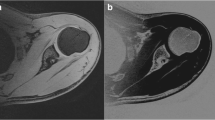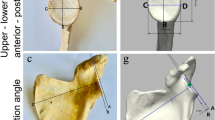Abstract
Purpose
The purpose of the study was to determine the normal three-dimensional relationship between the humeral and the glenoid plane of the individual patient. We measured the three-dimensional angle between the glenoid plane and the humeral plane (glenohumeral angle, °GH) and the angle between the plane of the scapula and the plane of the glenoid (glenoscapular angle, °GS) with the patient in a standardized position to the CT scan gantry. We hypothesized that a normal distribution with a small variation would exist for both angles.
Methods
A total of 150 conventional CT scans of normal shoulders from patients aged between 18 and 80 years were examined and three-dimensional reconstructions were derived from it. The descriptive statistics and the variability of °GH and °GS were determined.
Results
The mean °GH was 57.9°, and the mean °GS was −3.77°. The overall reliability of the measurement was good. Descriptive statistics of this study confirm the normal distribution and a narrow variation of both parameters.
Conclusions
This is the first study to determine the normal 3D relationship between the humerus and the glenoid (°GH). This new three-dimensional anatomical information of the normal glenohumeral relationship and glenoid can be used to distinguish normal from pathological anatomy, as well as alternative surgical guidance especially in bony deficient glenoids.
Level of Evidence Level II Anatomical Study.






Similar content being viewed by others
References
Boileau P, Walch G (1997) The three-dimensional geometry of the proximal humerus: implications for surgical technique and prosthetic design. J Bone Joint Surg Br 79:857–865. doi:10.1302/0301-620X.79B5.7579
Bryce CD, Davison AC, Lewis GS, Wang L, Flemming DJ, Armstrong AD (2010) Two dimensional glenoid version measurements vary with coronal and sagittal scapular rotation. J Bone Joint Surg Am 92:692–699. doi:10.2106/JBJS.I.00177
Churchill RS, Brems JJ, Kotschi H (2001) Glenoid size, inclination, and version: an anatomic study. J Shoulder Elbow Surg 10:327–332. doi:10.1067/mse.2001.115269
De Wilde LF, Berghs BM, VandeVyver F, Schepers A, Verdonk RC (2003) Glenohumeral relationship in the transverse plane of the body. J Shoulder Elbow Surg 12:260–267. doi:10.1016/S1058-2746(02)86884-7
De Wilde LF, Verstraeten T, Speeckaert W, Karelse A (2010) Reliability of the glenoid plane. J Shoulder Elbow Surg 19:414–422. doi:10.1016/j.jse.2009.10.005
Gallino M, Santamaria E, Doro T (1998) Anthropometry of the scapula: clinical and surgical considerations. J Shoulder Elbow Surg 7:284–291. doi:10.1016/S1058-2746(98)90057-X
Habermeyer P, Magosch P, Luz V, Lichtenberg S (2006) Three dimensional glenoid deformity in patients with osteoarthritis: a radiographic analysis. J Bone Joint Surg Am 88:1301–1307. doi:10.2106/JBJS.E.00622
Hertel R, Knothe U, Ballmer FT (2002) Geometry of the proximal humerus and implications for prosthetic design. J Shoulder Elbow Surg 11:331–338. doi:10.1067/mse.2002.124429
Huysmans PE, Haen PS, Kidd M, Dhert WJ, Willems JW (2006) The shape of the inferior part of the glenoid: a cadaveric study. J Shoulder Elbow Surg 15:759–763. doi:10.1016/j.jse.2005.09.001
Iannotti JP, Gabriel JP, Schneck SL, Evans BG, Misra S (1992) The normal glenohumeral relationships. J Bone Joint Surg Am 74:491–500
Karelse A, Kegels L, De Wilde LF (2007) The pillars of the scapula. Clin Anat 20(4):392–399. doi:10.1002/ca.20420
Khan A, Bunker TD, Kitson JB (2009) Clinical and radiological follow-up of the Aequalis third-generation cemented total shoulder replacement: a minimum ten-year study. J Bone Joint Surg Br 91:1594–1600. doi:10.1302/0301-620X.91B12.22139
Kummer FJ, Perkins R, Zuckerman JD (1998) The use of the bicipital groove for alignment of the humeral stem in shoulder 303 arthroplasty. J Shoulder Elbow Surg 7:144–146. doi:10.1016/S1058-2746(98)90225-7
Lewis GS, Bryce CD, Davison AC, Hollenbeak CS, Piazza SJ, Armstrong AD (2010) Location of the optimized centerline of the glenoid vault: a comparison of two operative techniques with use of three-dimensional computer modeling. J Bone Joint Surg Am 92:1188–1194. doi:10.2106/JBJS.I.00131
Mallon WJ, Brown HR, Vogler JB 3rd, Martinez S (1992) Radiographic and geometric anatomy of the scapula. Clin Orthop Relat Res 277:142–154. doi:31110.1097/00003086-199204000-00017
Nyffeler RW, Jost B, Pfirrmann CW, Gerber C (2003) Measurement of glenoid version: conventional radiographs versus computed tomography scans. J Shoulder Elbow Surg 12:493–496. doi:10.1016/S1058-2746(03)00181-2
Nyffeler RW, Sheikh R, Atkinson TS, Jacob HA, Favre P, Gerber C (2006) Effects of glenoid component version on humeral head displacement and joint reaction forces: an experimental study. J Shoulder Elbow Surg 15:625–629. doi:10.1016/j.jse.2005.09.016
Pearl ML (2005) Proximal humeral anatomy in shoulder arthroplasty: implications for prosthetic design and surgical technique. J Shoulder Elbow Surg 14:99S–104S. doi:10.1016/j.jse.2004.09.02
Pearl ML, Kurutz S, Postachini R (2009) Geometric variables in anatomic replacement of the proximal humerus: how much prosthetic geometry is necessary? J Shoulder Elbow Surg 18:366–370. doi:10.1016/j.jse.2009.01.011
Scalise JJ, Codsi MJ, Bryan J, Brems JJ, Iannotti JP (2008) The influence of three-dimensional computed tomography images of the shoulder in preoperative planning for total shoulder arthroplasty. J Bone Joint Surg Am 90:2438–2445. doi:10.2106/JBJS.G.0134
Scalise JJ, Codsi MJ, Bryan J, Iannotti JP (2008) The three-dimensional glenoid vault model can estimate normal glenoid version in osteoarthritis. J Shoulder Elbow Surg 17:487–491. doi:10.1016/j.jse.2007.09.006
Williams GR Jr, Iannotti JP (2007) Options for glenoid bone loss: composites of prosthetics and biologics. J Shoulder Elbow Surg 16(5Suppl):S267–S272. doi:10.1016/j.jse.2007.05.003
Wirth MA, Ondrla J, Southworth C, Kaar K, Anderson BC, Rockwood CA (2007) Replicating proximal humeral articular geometry with a third-generation implant: a radiographic study in cadaveric shoulders. J Shoulder Elbow Surg 16(3 Suppl):S111–S116. doi:10.1016/j.jse.2006.09.008
Wirth MA, Rockwood CA (1996) Complications of total shoulder replacement arthroplasty. J Bone Joint Surg Am 78:603–616
Kircher J, Wiedemann M, Magosch P, Lichtenberg S, Habermeyer P (2009) Improved accuracy of glenoid positioning in total shoulder arthroplasty with intraoperative navigation: a prospective-randomized clinical study. J Shoulder Elbow Surg 18(4):515–520
Ganapathi A, McCarron JA, Chen X, Iannotti JP (2011) Predicting normal glenoid version from the pathologic scapula: a comparison of 4 methods in 2- and 3-dimensional models. J Shoulder Elbow Surg 20(2):234–244. doi:10.1016/j.jse.2010.05.024
Shrout PE, Fleiss JL (1979) Intraclass correlations: uses in assessing rater reliability. Psychol Bull 86:420–428
Verborgt O, De Smedt T, Vanhees M, Clockaerts S, Parizel PM, Van Glabbeek F (2011) Accuracy of placement of the glenoid component in reversed shoulder arthroplasty with and without navigation. J Shoulder Elbow Surg 20(1):21–26
Acknowledgments
PD is a clinical investigator of the fund for Scientific Research, Flanders, Belgium. The authors wish to thank Steffen Fieuws for help with the statistical analysis.
Conflict of interest
The authors declare that they have no conflict of interest.
Author information
Authors and Affiliations
Corresponding author
Rights and permissions
About this article
Cite this article
De Wilde, L., Defoort, S., Verstraeten, T.R.G.M. et al. A 3D-CT scan study of the humeral and glenoid planes in 150 normal shoulders. Surg Radiol Anat 34, 743–750 (2012). https://doi.org/10.1007/s00276-011-0836-4
Received:
Accepted:
Published:
Issue Date:
DOI: https://doi.org/10.1007/s00276-011-0836-4




